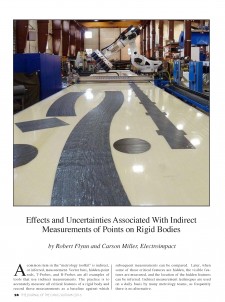
|
Download Members: $0.00 Non‑Members: $75.00 |
Buy Now |
Publication Details
| Published Date: | |
|---|---|
| Authors: | Robert Flynn, Carson Miller |
| Company: | CMSC |
| Print Format: | Technical Paper |
| Citation: | Robert Flynn, Carson Miller, "Effects and Uncertainties Associated With Indirect Measurements of Points on Rigid Bodies," The Journal of the CMSC, Vol. 11, No. 2, Autumn 2016 |
Abstract
A common item in the “metrology toolkit” is indirect, or inferred, measurement. Vector bars, hidden-point rods, T-Probes, and B-Probes are all examples of tools that use indirect measurements. The practice is to accurately measure all critical features of a rigid body and record those measurements as a baseline against which subsequent measurements can be compared. Later, when some of those critical features are hidden, the visible features are measured, and the location of the hidden features can be inferred. Indirect measurement techniques are used on a daily basis by many metrology teams, as frequently there is no alternative. However, when one of our customers recently challenged the use of indirect measurement, it became necessary to generate some data to support the use of inferred points. To this end, a laser tracker-based test was developed to validate the use of indirect measurements and to quantify the uncertainty of an inferred point. The process, in a nutshell, is to very carefully measure a small group of points—seven flag points and the tool point— by using multiple laser tracker stations to establish accurate nominal values. The same points are then measured from a new series of stations, varying the aspect ratio and number of points used to infer the points. The resulting study, presented in this article, provided some quantitative justification for the sizing of uncertainties during the use of inferred points, and the related uncertainties for various aspect ratios, as well as the effect of the measured point count on accuracy. The study also helped identify the point of diminishing returns for these variables.





